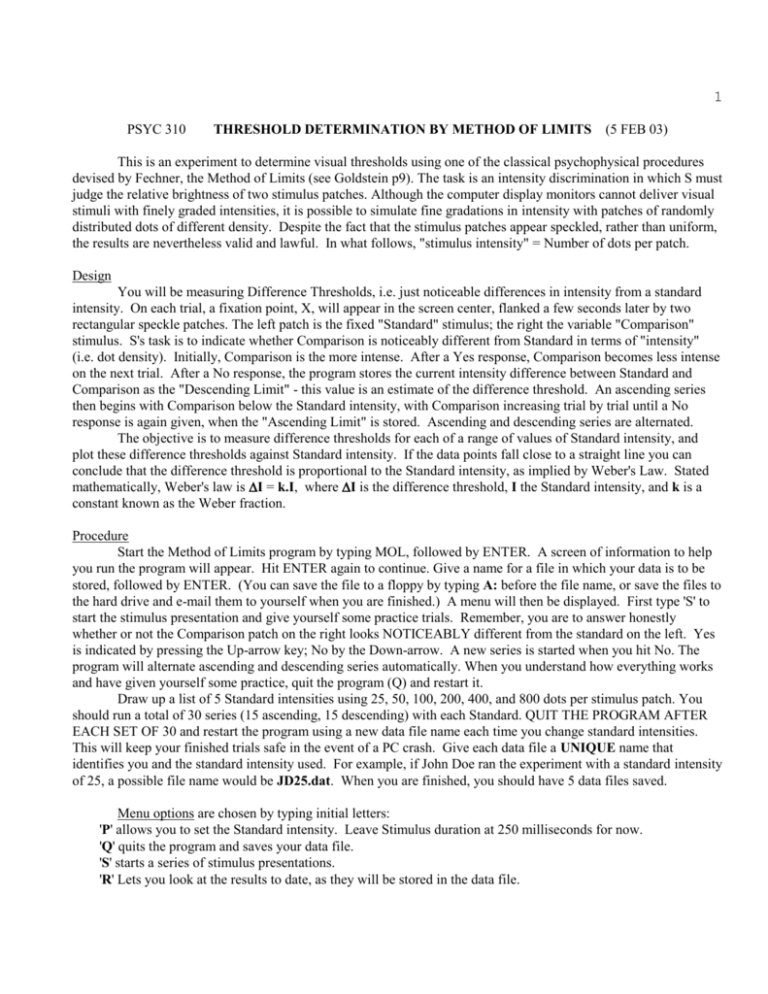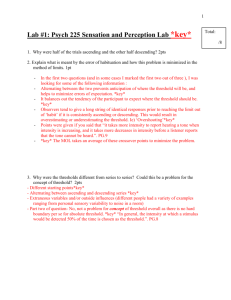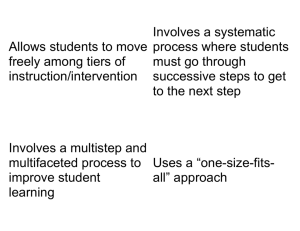PSY 310 THRESHOLD DETERMINATION BY METHOD OF LIMITS
advertisement

1 PSYC 310 THRESHOLD DETERMINATION BY METHOD OF LIMITS (5 FEB 03) This is an experiment to determine visual thresholds using one of the classical psychophysical procedures devised by Fechner, the Method of Limits (see Goldstein p9). The task is an intensity discrimination in which S must judge the relative brightness of two stimulus patches. Although the computer display monitors cannot deliver visual stimuli with finely graded intensities, it is possible to simulate fine gradations in intensity with patches of randomly distributed dots of different density. Despite the fact that the stimulus patches appear speckled, rather than uniform, the results are nevertheless valid and lawful. In what follows, "stimulus intensity" = Number of dots per patch. Design You will be measuring Difference Thresholds, i.e. just noticeable differences in intensity from a standard intensity. On each trial, a fixation point, X, will appear in the screen center, flanked a few seconds later by two rectangular speckle patches. The left patch is the fixed "Standard" stimulus; the right the variable "Comparison" stimulus. S's task is to indicate whether Comparison is noticeably different from Standard in terms of "intensity" (i.e. dot density). Initially, Comparison is the more intense. After a Yes response, Comparison becomes less intense on the next trial. After a No response, the program stores the current intensity difference between Standard and Comparison as the "Descending Limit" - this value is an estimate of the difference threshold. An ascending series then begins with Comparison below the Standard intensity, with Comparison increasing trial by trial until a No response is again given, when the "Ascending Limit" is stored. Ascending and descending series are alternated. The objective is to measure difference thresholds for each of a range of values of Standard intensity, and plot these difference thresholds against Standard intensity. If the data points fall close to a straight line you can conclude that the difference threshold is proportional to the Standard intensity, as implied by Weber's Law. Stated mathematically, Weber's law is I = k.I, where I is the difference threshold, I the Standard intensity, and k is a constant known as the Weber fraction. Procedure Start the Method of Limits program by typing MOL, followed by ENTER. A screen of information to help you run the program will appear. Hit ENTER again to continue. Give a name for a file in which your data is to be stored, followed by ENTER. (You can save the file to a floppy by typing A: before the file name, or save the files to the hard drive and e-mail them to yourself when you are finished.) A menu will then be displayed. First type 'S' to start the stimulus presentation and give yourself some practice trials. Remember, you are to answer honestly whether or not the Comparison patch on the right looks NOTICEABLY different from the standard on the left. Yes is indicated by pressing the Up-arrow key; No by the Down-arrow. A new series is started when you hit No. The program will alternate ascending and descending series automatically. When you understand how everything works and have given yourself some practice, quit the program (Q) and restart it. Draw up a list of 5 Standard intensities using 25, 50, 100, 200, 400, and 800 dots per stimulus patch. You should run a total of 30 series (15 ascending, 15 descending) with each Standard. QUIT THE PROGRAM AFTER EACH SET OF 30 and restart the program using a new data file name each time you change standard intensities. This will keep your finished trials safe in the event of a PC crash. Give each data file a UNIQUE name that identifies you and the standard intensity used. For example, if John Doe ran the experiment with a standard intensity of 25, a possible file name would be JD25.dat. When you are finished, you should have 5 data files saved. Menu options are chosen by typing initial letters: 'P' allows you to set the Standard intensity. Leave Stimulus duration at 250 milliseconds for now. 'Q' quits the program and saves your data file. 'S' starts a series of stimulus presentations. 'R' Lets you look at the results to date, as they will be stored in the data file. 2 The handout “Writing a Scientific Paper” tells you what sort of material goes in each section of your paper. Here are some points to address in each section - include other relevant points that occur to you. Data analysis is explained in the Results section. The handout can be found by clicking “Scientific Paper” at: http://www.udel.edu/psych/sgallagh/ INTRODUCTION What is the aim of this experiment? What is the hypothesis that you are testing? METHODS Describe: S, stimulus viewing conditions, and other relevant factors. The order of presentation of Standard stimuli – this might have a bearing on the results because of practice effects. RESULTS Data analysis: In your data files, each ascending and descending series gives you one estimate of the difference threshold (I): it is given by the crossover point between 'yes' and 'no'. For example, if on a descending series the last yes was at a comparison intensity of 40, and the no at 35, the estimate of I will be 37.5. For each Standard intensity, average the ascending and descending I's together, and calculate the standard deviation. (In your data file, descending series are indicated by Direc = -1; ascending series by Direc = 1). Graph the averaged I (on Y-axis) against I, the Standard intensity (X-axis) with standard error (SE) as error bars on each point. (What does SE mean exactly?). What is the form of the relationship between I and I (Standard intensity)? To answer this, calculate a regression line with I as dependent variable, and I as independent variable. Draw the regression line through your data. Report slope and intercept. DISCUSSION Methodological issues: What are the pros and cons of this method of measuring threshold? How could you make it more reliable? Explain any systematic differences between ascending and descending series. Practice effects? Theoretical issues Was Weber's Law obeyed? Compare your intercept with that predicted by Weber's Law. The slope gives the Weber Fraction, k, which is often expressed as a percentage - just multiply k by 100. If you were an exceptionally sensitive subject, would your k be higher or lower than most others?






